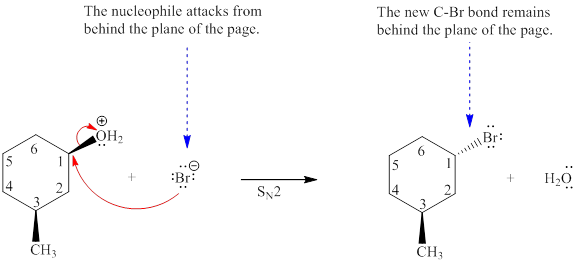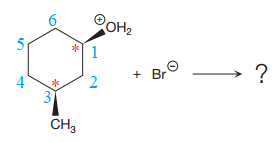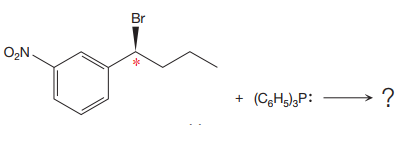
Concept explainers
(a)
Interpretation:
The complete, detailed mechanism and products for the given reaction are to be drawn assuming that it takes place via an
Concept introduction:
Answer to Problem 8.13P
The complete, detailed mechanism for the given reaction, assuming that it takes place via an

Explanation of Solution
The given reaction is:

The reactant molecule contains one chiral center at the C2 carbon atom. The leaving group is

In given alkyl halide C2 carbon atom is chiral in nature and affected throughout the course of the reaction. The nucleophile
For the given
(b)
Interpretation:
The complete, detailed mechanism and products for the given reaction are to be drawn assuming that it takes place via an
Concept introduction:
Answer to Problem 8.13P
The complete, detailed mechanism for the given reaction, assuming that it takes place via an

Explanation of Solution
The given reaction is

The reactant molecule contains two chiral centers at C1 and C3 carbon atoms. The leaving group is

Note that the stereochemical configuration at the chiral center at C3 remains unchanged because no bonds to it were broken or formed. However, the stereochemical configuration at the chiral center at C1 changes as bonds to it are affected throughout the course of reaction. This will change the stereochemical configuration at C3 chiral carbon atom. Thus, a single stereoisomer will be generated.
For the given
(c)
Interpretation:
The complete, detailed mechanism and products for the given reaction are to be drawn assuming that it takes place via an
Concept introduction:
Answer to Problem 8.13P
The complete, detailed mechanism for the given reaction, assuming that it takes place via an

Explanation of Solution
The given reaction is

The reactant molecule contains one chiral center. The leaving group is

Note that, the stereochemical configuration at the chiral center changes as bonds to it ae affected throughout the course of reaction. This will change the stereochemical configuration at the chiral center, and it will be opposite than the reactant molecule. Thus, a single stereoisomer will be generated.
For the given
Want to see more full solutions like this?
Chapter 8 Solutions
Organic Chemistry: Principles and Mechanisms (Second Edition)
- (12) Which one of the following statements about fluo- rometry is FALSE? a) Fluorescence is better detected at 90 from the exci- tation direction. b) Fluorescence is typically shifted to longer wave- length from the excitation wavelength. c) For most fluorescent compounds, radiation is pro- duced by a transitionarrow_forwardDon't used Ai solutionarrow_forwardDon't used Ai solutionarrow_forward
- Don't used Ai solutionarrow_forwardIndicate the correct option.a) Graphite conducts electricity, being an isotropic materialb) Graphite is not a conductor of electricityc) Both are falsearrow_forward(f) SO: Best Lewis Structure 3 e group geometry:_ shape/molecular geometry:, (g) CF2CF2 Best Lewis Structure polarity: e group arrangement:_ shape/molecular geometry: (h) (NH4)2SO4 Best Lewis Structure polarity: e group arrangement: shape/molecular geometry: polarity: Sketch (with angles): Sketch (with angles): Sketch (with angles):arrow_forward
- 1. Problem Set 3b Chem 141 For each of the following compounds draw the BEST Lewis Structure then sketch the molecule (showing bond angles). Identify (i) electron group geometry (ii) shape around EACH central atom (iii) whether the molecule is polar or non-polar (iv) (a) SeF4 Best Lewis Structure e group arrangement:_ shape/molecular geometry: polarity: (b) AsOBr3 Best Lewis Structure e group arrangement:_ shape/molecular geometry: polarity: Sketch (with angles): Sketch (with angles):arrow_forward(c) SOCI Best Lewis Structure 2 e group arrangement: shape/molecular geometry:_ (d) PCls Best Lewis Structure polarity: e group geometry:_ shape/molecular geometry:_ (e) Ba(BrO2): Best Lewis Structure polarity: e group arrangement: shape/molecular geometry: polarity: Sketch (with angles): Sketch (with angles): Sketch (with angles):arrow_forwardDon't used Ai solutionarrow_forward
 Organic Chemistry: A Guided InquiryChemistryISBN:9780618974122Author:Andrei StraumanisPublisher:Cengage Learning
Organic Chemistry: A Guided InquiryChemistryISBN:9780618974122Author:Andrei StraumanisPublisher:Cengage Learning
